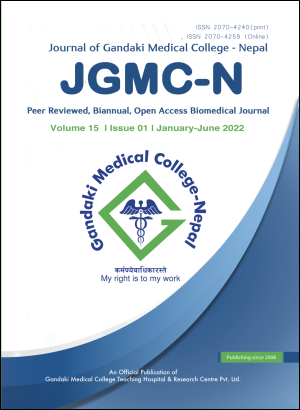Monopolar versus bipolar cautery in tonsillectomy: A comparative study
DOI:
https://doi.org/10.3126/jgmcn.v15i1.44897Keywords:
Tonsillectomy, Monopolar cautery, Bipolar cautery, Postoperative pain, Postoperative haemorrhageAbstract
Introduction: Tonsillectomy is the most commonly performed surgeries in otolaryngology. Despite the evolution in surgical and anaesthetic techniques, pain and bleeding are still the most important surgical complications. This study was done to compare the pain and bleeding following tonsillectomy using monopolar and bipolar cautery techniques in our population.
Methods: It was a prospective, longitudinal study done over a period of one year at Gandaki Medical College, Pokhara, Nepal. Total 45 patients who underwent tonsillectomy by either monopolar or bipolar cautery were included in the study and assessed for postoperative pain and haemorhage. The data was entered in Microsoft Excel and further analysis done by statistical package for the social sciences 16.0. The association of variables was be tested by Chi square test and p-value of less than 0.05 was considered significant. Confidence interval was be kept at 95%.
Results: Out of the 45 patients who underwent tonsillectomy, 35.5% were males and 64.5% were females. The age of patients varied from 16 to 60 years. Mean age of the patients was 27.5 years. Fourty percent of the total patients underwent tonsillectomy by monopolar cautery whereas 60% patients were operated by bipolar cautery. No statistically significant difference was found between the two groups regarding age, sex ratio, postoperative pain and bleeding.
Conclusions: Both monopolar and bipolar cautery are equally effective methods of tonsillectomy in terms of postoperative pain and haemorrhage.
Downloads
Downloads
Published
How to Cite
Issue
Section
License
Copyright (c) 2022 Neeraj K.C., Rajendra Nepali, Tulika Dubey

This work is licensed under a Creative Commons Attribution-NonCommercial 4.0 International License.
This license allows reusers to distribute, remix, adapt, and build upon the material in any medium or format for noncommercial purposes only, and only so long as attribution is given to the creator.




